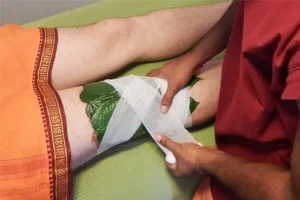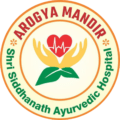Upnaah

Ayurveda, a centuries-old traditional system of medicine, has evolved into various branches, each offering distinct approaches to wellness. Upnaah Ayurvedic treatment is one such specialization that has gained recognition for its unique methodologies and comprehensive healing techniques.
In the vast landscape of holistic health practices, Upnaah Ayurvedic treatment stands out as a beacon of natural healing. Rooted in the ancient principles of Ayurveda, this specialized approach offers a tailored and focused way to address various health concerns.
What is Upnaah Ayurvedic Treatment
“Upnaah” is a therapeutic procedure in Ayurveda that involves the application of a medicinal paste or poultice over a specific area of the body. This herbal paste is prepared by combining various Ayurvedic herbs, grains, and other natural ingredients. The application is followed by appropriate bandaging. Upnaah therapy aims to provide localized relief, reduce inflammation, and promote healing in the targeted region. It is often used to address musculoskeletal issues, joint pain, and certain skin conditions. The choice of herbs in the paste is tailored to the individual’s constitution and the specific condition being treated.
Ingredients used in Upnaah
- Turmeric (Curcuma longa): Known for its anti-inflammatory and antioxidant properties, turmeric is often used to reduce swelling and promote healing in the applied area.
- Neem (Azadirachta indica): With antimicrobial and anti-inflammatory properties, neem is used to address skin conditions and infections. It can support the healing process.
- Ginger (Zingiber officinale): Ginger is valued for its anti-inflammatory and analgesic properties. It may help in reducing pain and inflammation in the targeted area.
- Garlic (Allium sativum): Garlic has antimicrobial and anti-inflammatory properties, making it useful in managing skin conditions and infections.
- Sesame Oil (Sesamum indicum): Sesame oil is often used as a base for preparing the herbal paste. It provides a lubricating effect and helps in the absorption of herbal constituents.
- Castor Oil (Ricinus communis): Castor oil is known for its anti-inflammatory properties and is used to enhance the therapeutic effects of the herbal paste.
- Indian Lilac (Syzygium aromaticum): Indian lilac, also known as clove, possesses antimicrobial properties and can contribute to the paste’s ability to address infections.
- Aloe Vera (Aloe barbadensis miller): Aloe vera is known for its soothing and cooling effects on the skin. It can be included to support skin healing.
- Rock Salt (Saindhava): Rock salt may be added to the paste for its cleansing and detoxifying properties.
Procedure of Upnaah
A. Preparation:
- Consultation: The process begins with a consultation with an Ayurvedic practitioner to determine the specific condition to be addressed and the appropriate herbal ingredients for the Upnaha paste.
- Selection of Ingredients: The practitioner selects herbs, oils, and other natural substances based on their therapeutic properties and their suitability for the individual’s constitution and condition.
- Fresh Preparation: The Upnaha paste is freshly prepared before each application to ensure maximum potency and effectiveness. The herbs are ground, mixed, and sometimes heated to form a cohesive and beneficial paste.
B. Application of Upnaah:
- Preparation of the Area: The targeted area of the body is cleansed to remove any dirt, oil, or impurities. In some cases, a brief massage or fomentation (Swedana) may precede the application to prepare the tissues.
- Application of the Paste: The prepared herbal paste is then applied evenly to the specific area of the body. It can be spread directly on the skin or sometimes wrapped in a cloth or leaf and then applied.
- Secure Placement: The paste is securely placed over the affected area and covered with a clean cloth or bandage to keep it in position.
C. Duration and Removal:
- Duration of Application: The duration for which the Upnaah paste is left on the skin varies depending on the condition being treated. It can range from a specific time period, such as 30 minutes to an hour, to overnight applications.
- Removal: After the designated time, the herbal paste is removed. This can be done by gently wiping or washing off the paste using warm water or a specific herbal decoction.
D. Post-Therapy Care:
- Cleansing: The treated area may be cleansed to remove any residual herbal material. Gentle oils or herbal applications might be used to soothe the skin.
- Rest: After the therapy, individuals may be advised to rest and avoid exposure to extreme conditions like cold drafts or direct sunlight.
Conditions Treated with Upnaah
Upnaha therapy in Ayurveda is employed to treat various conditions, providing therapeutic benefits to individuals. Some of the common conditions treated with Upnaha therapy include:
1. Musculoskeletal Disorders:
Upnaha therapy is frequently used for addressing musculoskeletal issues such as joint pain, arthritis, stiffness, and inflammation. The herbal paste applied during Upnaha helps alleviate pain and promotes the health of joints and surrounding tissues.
2. Skin Disorders:
Skin conditions like eczema, psoriasis, dermatitis, and other inflammatory skin disorders can be treated with Upnaha therapy. The herbal paste, chosen for its skin-healing properties, is applied to the affected skin areas.
3. Localized Pain and Swelling:
Upnaha is beneficial for localized pain and swelling due to injuries, sprains, or strains. The application of the herbal paste helps in reducing inflammation and promoting the healing of injured tissues.
4. Wound Healing:
Upnaha therapy is employed to aid in the healing of wounds, cuts, and abrasions. The herbal ingredients in the paste contribute to the regeneration of skin cells and support the natural healing process.
5. Neurological Conditions:
Some neurological conditions, especially those involving nerve pain or inflammation, may be addressed with Upnaha therapy. The application of the herbal paste can have a soothing effect on nerves.
6. Localized Ailments:
Upnaha therapy can be applied to address various localized ailments, depending on the herbal composition of the paste. It is tailored to the specific needs of the individual and the nature of the ailment.
FAQs
- Upnaah Ayurveda is tailored to individual constitutions, making it suitable for a wide range of people. However, it’s advisable to consult with a practitioner to determine its appropriateness for specific health conditions.
- The timeline for results varies based on individual health concerns. Some may experience improvements within a few weeks, while others may require more extended treatment periods.
- Upnaah Ayurveda often provides personalized dietary recommendations based on individual constitutions. Practitioners may suggest specific dietary adjustments, but these are tailored to each person’s needs.
Uniqueness of our therapies
At Arogya Mandir – Shri Siddhanath Ayurvedic Hospital, Miraj, we delve deeply into the ayurvedic examination of each patient. Utilizing noninvasive Ayurvedic diagnostic tools such as Ashtavidha Parikshan and Nadi Parikshan, we precisely determine the pathogenesis of the disease and then prescribe therapies tailored to the specific condition. This approach leads to expedited results.
Our therapies boast the following distinctive features:
– Tranquil and hygienic therapy rooms staffed with trained therapists in a positive environment.
– Selection of appropriate massage oil based on the patient’s Prakruti and the condition of the disease.
– Complimentary Prakruti and Dhatu Sarata examinations before the commencement of therapies.
– Authenticated procedures for each therapy.
– Judicious use of herbal medicines and instruments during the therapy sessions.
– Specialized rooms equipped with all facilities for inpatient care.
Feel free to share this article at no cost.
Copyright message – Dr. Prashant Chivate has published this article on drchivateayurved.org for informational purposes about diseases. Any other use of this article is strictly prohibited. All rights reserved.
